Piping diagram for a gas heating boiler: general principles and recommendations
Connecting gas heating is one of the most important stages of building improvement.Comfort in the home for many years depends on the quality of the selected materials and installation work. The correct piping scheme for a gas heating boiler protects the system from overloads and ensures uniform heating of all rooms.
The article we propose provides rules and practice-tested wiring diagrams for heating equipment. Recommendations are given to ensure the quality of assembly and further impeccable operation of the boiler. The information we provide is based on building regulations.
The content of the article:
Why is proper strapping so important?
Piping refers to pipes and mechanisms designed to supply coolant from the boiler to the radiators. This is almost the entire heating system, with the exception of the batteries.
The system consists of many components, but even a non-professional can install the simplest boiler piping. But if you need a complex circuit, it is better to contact an experienced craftsman.
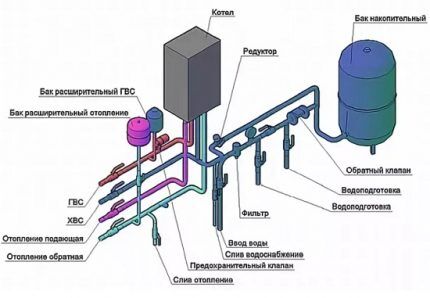
The choice of piping scheme for each specific house depends on the type of boiler, construction features, and type of heating system.
Any gas equipment is dangerous. Incorrect connection is fraught not only with heating problems, but also with explosions and destruction, so it is necessary to strictly follow the rules and regulations and comply with safety requirements. The main documentation that is relied upon when installing a gas heating system is SNiP.
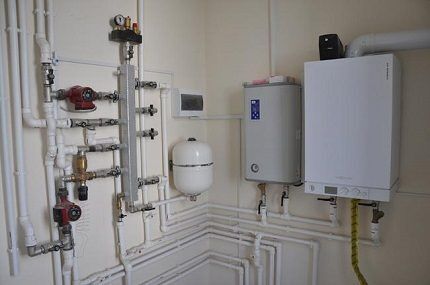
Needs careful planning heating scheme, equipment location, features of pipeline laying.
The boiler piping performs several significant functions at once:
- Pressure control. If the piping is installed correctly, thermal expansion is compensated, which means that the pressure in the system will not increase to critical levels.
- Removing air. Air bubbles form plugs, which reduces the efficiency of water heating: radiators do not warm up completely, but resource consumption remains the same. High-quality boiler piping is necessary to prevent this problem.
- Preventing blockages in the system. If the boiler is not properly sealed, the risk of scale formation in radiators and pipes increases. Small debris in the coolant pollutes the system, which leads to excessive fuel consumption and increased heating costs while simultaneously reducing its quality.
- Possibility of connecting other circuits. You can install an underfloor heating system and a storage boiler.
In many ways, heat supply depends on the correct connection of the boiler to pipelines and other important components, so the gas boiler piping scheme must be carefully thought out and installed as efficiently as possible.
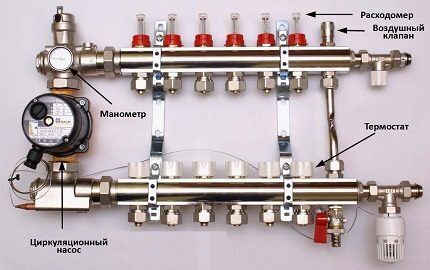
A correctly selected and installed boiler piping will last for many years without accidents or repairs, and its cost will be optimal.
Main components and elements of the system
To install a gas pipeline, you will need the following devices:
- pressure gauge;
- circulation pump;
- expansion tank;
- drain tap;
- ball valve;
- balancing valve;
- filtration system;
- valves (distribution, check, safety, etc.).
Each of the units performs its own functions, and the need for their installation is determined by the design of the heating equipment. So, if the pump is initially included in the boiler package, then it does not need to be purchased separately.
Shut-off devices, pressure monitoring devices and protective systems must be installed in the gas boiler piping.Moreover, all components should be carefully selected, and saving on them is fraught with breakdowns.
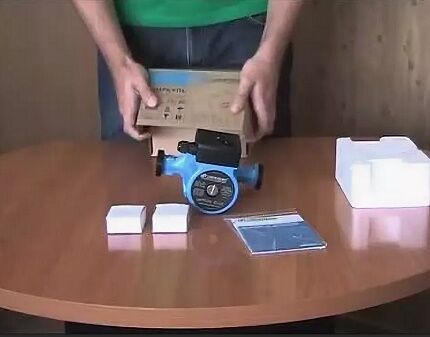
It is worth overpaying for equipment and pipes from manufacturers with a good reputation. This is much cheaper than repairing the heating later.
Polypropylene - the optimal solution
Many experts are in favor piping gas equipment with polypropylene. Their main argument is versatility and the ability to implement any scheme without any problems. On the other hand, an inexperienced master is unlikely to have to deal with systems of increased complexity.
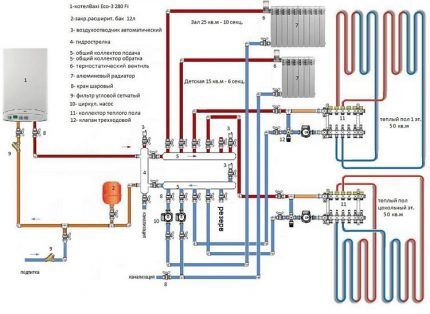
The main advantage of polypropylene pipelines is reliability. According to the manufacturers, their products last 40 years or more.
The material is resistant to high pressure (can withstand up to 25 bar), tolerates water hammer and temperatures of 95 degrees. There is also a drawback that must be taken into account: such a boiler piping reduces the efficiency of the heating system.
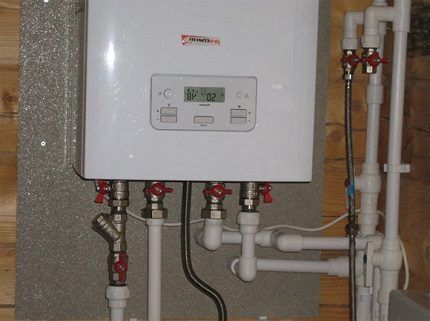
The connection of the boiler to the gas pipeline must be rigid (“American”, metal fitting). Of all types of gaskets, only paronite gaskets are suitable, because...plastic materials (rubber, foam, tow) are deformed, which leads to loss of tightness or a decrease in the internal diameter of the gas pipeline.
Location and installation of a gas boiler
The basic rule for choosing a location floor boiler: It should not be located above the batteries. If you do not adhere to it, air bubbles may appear and blockages may form in the system. The pipe leaving the boiler must be positioned strictly vertically.
If the choice is made in favor of a wall-mounted model, then it must be equipped with an automatic air vent. When developing a wiring diagram, be sure to take such nuances into account.

Many modern models are pre-equipped with all the necessary additional devices: expansion tanks, protective systems, pumps. Their disadvantage is their high price compared to “simple” boilers.
Features of different strapping schemes
The coolant moves through the pipeline due to the slope of the system or is forcibly pumped circulation pump. Depending on this, the boiler piping scheme is selected.
Method 1: strapping in gravity systems
Boiler piping in gravity heating system It is simple and can be installed by anyone who knows how to use tools. The coolant moves in accordance with physical laws.
This does not require any equipment. The operation of the system does not depend on electricity, so a sudden shutdown will not affect the quality of heating.
Piping the boiler will cost minimal money, because... you don’t have to buy additional devices or pay a team of craftsmen for installation. The operation of such a system is also cheap, and breakdowns can be corrected independently.
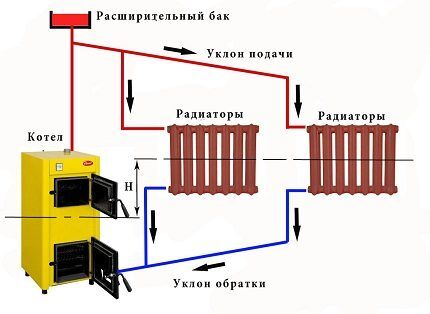
The only negative: this scheme can only be used for a small house. In addition, you will have to carefully calculate the diameter of the pipes and double-check the data repeatedly, otherwise normal heating of the house cannot be guaranteed. A large diameter pipeline spoils the interior and is difficult to disguise.
Method 2: connecting the boiler with a circulation pump
Systems with pumping equipment are easier to manage than gravity systems. At forced heating device piping the boiler is more complicated and expensive, but the result is a comfortable temperature in all rooms.
This heating is energy-dependent, so it is advisable to play it safe and install it in such a way that if there is a power outage, you can switch the system to the gravitational coolant circulation mode.
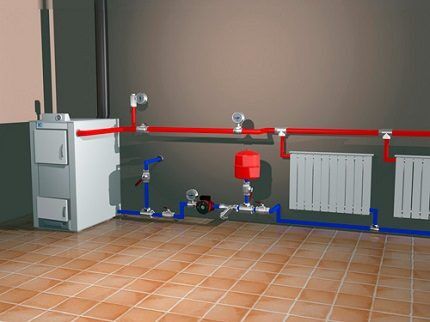
The boiler piping scheme is complicated by additional devices that will require regular maintenance during operation. Without experience, it is difficult to do it yourself, so you will have to hire craftsmen and pay for their work.
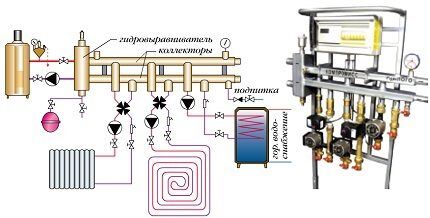
To minimize the number of additional devices, you can implement a circuit with primary-secondary rings with circulation pumps in each of them. If the boiler power is less than 50 kW, then collectors should be included in the circuit, otherwise the batteries will heat up unevenly.
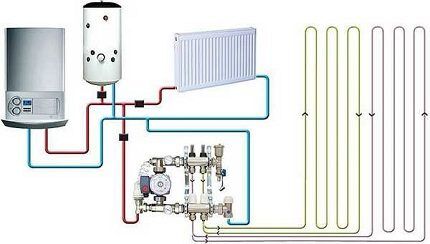
The best boiler piping for heating a small house is the simplest. There is no need to install unnecessary devices, because the simpler the design, the more reliable. However, for a spacious building with several heating circuits, it is worth choosing a scheme with forced movement of coolant and a comb collector.
7 recommendations from experienced professionals
For each heating system, the piping scheme is selected individually, and the methods of its implementation can also vary greatly.
However, there are a few general guidelines to follow:
- The boiler is installed in accordance with regulatory requirements below the level of the radiators. If the model is floor-standing, then there must be a non-flammable material underneath it - metal, concrete or clay. If it is wall-mounted, then access to it should be free. Ventilation and lighting are required.
- The gas boiler piping includes a coaxial chimney. When connecting it, care must be taken to ensure the tightness of the joints.
- After installing the boiler and chimney, they begin to install the safety group in this order: a pressure gauge, then a safety valve, and after that an automatic air vent.
- A 1.25-inch pipeline is connected to the manifold, along which protective systems, a pump, a hydraulic arrow, and another air vent are installed.
- To supply coolant to the radiators, 3 one-inch pipes are removed from the comb, and the remaining pipes are closed with plugs. After this, radiators and return pipes are installed and connected.
- If the system is combined (“2 in 1”), then the heated floor circuit is supplied with a separate pump.
- The expansion tank is placed between the hydraulic arrow and the boiler.
Sometimes you have to install boiler automation devices. This is required if the boiler piping provides a complex heating control system. Then the temperature sensor is mounted outside, and a thermostat is installed in the room.
Will familiarize you with the rules and guidelines for adjusting the automation for a gas heating unit next article, which we strongly recommend reading.
Conclusions and useful video on the topic
We offer several video tutorials that will help solve the problem of piping a gas boiler.
Video #1. Expert advice on lining a boiler with polypropylene (simple diagram):
Video #2. Instructions for installing complex piping of a wall-mounted boiler model:
Video #3. Nuances of connecting a floor-standing model:
It is advisable to choose a gas piping scheme that can be installed without outside help. However, if in doubt, professional advice will not hurt.
Pay special attention to the choice of pipeline material, take care to install a filter to clean the coolant.Smooth inner walls of pipes and clean water in them are the key to long-term and stable operation of the heating system.
Please write comments in the block below. It is possible that you know the technical details of boiler piping that are not mentioned in the article. Share useful information, ask questions, post photos related to the topic of the article.




I have an old house, inherited from my grandmother, it was heated by a stove. There is gas in the village, they connected us, I installed the boiler. I did the simplest wiring and wiring myself. The pipes are metal, I assembled everything using pipes, only the expansion tank was ordered from stainless steel.
The diameter of the pipes is, of course, large, an inch and a half, it doesn’t look very good, but it will do. Natural circulation works fine.
True, I would like to install a pump through the bypass so that it warms up faster and the return flow does not cool down so much, but this is still in my dreams.